The Distribution of Gas Components within a Shale System and Its Implication for Migration
Abstract
:1. Introduction
2. Geological Background
3. Sampling and Experiments
4. Experimental Results
5. Origins of Shale Gas Sampling
6. Discussion
6.1. Classification of Generated Gas, Retained Gas and Migrated Gas
6.2. Migration of Different Gas Components
7. Conclusions
Author Contributions
Funding
Acknowledgments
Conflicts of Interest
References
- Bertard, C.; Bruyet, B.; Gunther, J. Determination of desorbable gas concentration of coal (direct method). Int. J. Rock Mech. Min. Sci. Geomech. Abstr. 1970, 7, 43–65. [Google Scholar] [CrossRef]
- Yee, D.; Seidle, J.P.; Hanson, W.B. Gas Sorption on Coal and Measurement of Gas Content. In Hydrocarbons from Coal; American Association of Petroleum Geologists: Tulsa, OK, USA, 1993; pp. 203–218. ISBN 978-1-6298-1104-8. [Google Scholar]
- Han, H.; Li, D.; Ma, Y.; Cheng, L.; Zhong, N. The origin of marine shale gas in the northeastern Sichuan Basin, China: Implications from chemical composition and stable carbon isotope of desorbed gas. Shiyou Xuebao/Acta Pet. Sin. 2013, 34, 453–459. [Google Scholar]
- Fan, B.J.; Wang, X.Z.; Shi, L. Gas desorption of low-maturity lacustrine shales, trassic yanchang formation, Ordos Basin, China. Open Geosci. 2018, 10, 688–698. [Google Scholar] [CrossRef]
- Sun, Z.P.; Wang, Y.L.; Wei, Z.F.; Zhang, M.F.; Wang, G.; Wang, Z.X. Characteristics and origin of desorption gas of the Permian Shanxi Formation shale in the Ordos Basin, China. Energy Explor. Exploit. 2017, 35, 792–806. [Google Scholar] [CrossRef] [Green Version]
- Stainforth, J.G. Practical kinetic modeling of petroleum generation and expulsion. Mar. Pet. Geol. 2009, 26, 552–572. [Google Scholar] [CrossRef]
- Stewart, B.W.; Capo, R.C.; Kirby, C.S. Geochemistry of unconventional shale gas from formation to extraction: Petrogenesis, hydraulic fracturing, and environmental impacts. Appl. Geochem. 2015, 60, 1–2. [Google Scholar] [CrossRef]
- Bruns, B.; Littke, R.; Gasparik, M.; van Wees, J.D.; Nelskamp, S. Thermal evolution and shale gas potential estimation of the Wealden and Posidonia Shale in NW-Germany and the Netherlands: A 3D basin modelling study. Basin Res. 2016, 28, 2–33. [Google Scholar] [CrossRef] [Green Version]
- Charoensuppanimit, P.; Mohammad, S.A.; Gasem, K.A. Measurements and modeling of gas adsorption on shales. Energy Fuels 2016, 30, 2309–2319. [Google Scholar] [CrossRef]
- Hu, Z.Q.; Du, W.; Sun, C.X.; Wu, J.; Zhu, T.; Zhao, J.H.; Yan, C.N. Evolution and migration of shale facies and their control on shale gas: A case study from the Wufeng-Longmaxi Formations in the Sichuan Basin and its surroundings. Interpretation 2018, 6, 57–70. [Google Scholar] [CrossRef]
- Wang, X.Z. Characteristics of Chang 7 shale gas in the triassic Yanchang formation, Ordos basin, China. Interpretation 2017, 5, 31–39. [Google Scholar] [CrossRef]
- Cui, J.W.; Zhu, R.K.; Luo, Z.; Li, S. Sedimentary and geochemical characteristics of the Triassic Chang 7 member shale in the southeastern Ordos Basin, Central China. Pet. Sci. 2019, 16, 285–297. [Google Scholar] [CrossRef] [Green Version]
- Zhang, T.W.; Sun, X.; Ruppel, S.C. Hydrocarbon geochemistry and pore characterization of the Bakken Formation and implications for oil migration and oil saturation. In Proceedings of the 2013 Meeting of Mudrock Systems Research Laboratory, Pittsburgh, PA, USA, 19–22 May 2013; pp. 166–178. [Google Scholar]
- Neal, R.O. Shale lamination and sedimentary processes. Geol. Soc. Lond. Spec. Publ. 1996, 116, 23–36. [Google Scholar] [CrossRef]
- Fathi, E.; Akkutlu, I.Y. Matrix heterogeneity effects on gas transport and adsorption in coalbed and shale gas reservoirs. Transp. Porous Media 2009, 80, 281–304. [Google Scholar] [CrossRef]
- McCarthy, J.F. Analytical models of the effective permeability of sand-shale reservoirs. Geophys. J. Int. 1991, 105, 513–527. [Google Scholar] [CrossRef] [Green Version]
- Tao, H.; Pang, X.Q.; Shu, J.; Wang, Q.F.; Zheng, X.W.; Ding, X.G.; Zhao, Y.; Zhu, C.X.; Hui, L. Oil content evaluation of lacustrine organic-rich shale with strong heterogeneity: A case study of the middle permian lucaogou formation in jimusaer sag, junggar basin, NW China. Fuel 2018, 221, 196–205. [Google Scholar]
- Fan, B.J.; Shi, L.; Li, Y.T.; Zhang, T.J.; Lv, L.; Tong, S.K. Lithologic heterogeneity of lacustrine shale and its geological significance for shale hydrocarbon-a case study of Zhangjiatan shale. Open Geosci. 2019, 11, 101–112. [Google Scholar] [CrossRef]
- Li, H.; Tang, H.M.; Zheng, M.J. Micropore structural heterogeneity of siliceous shale reservoir of the Longmaxi formation in the southern Sichuan Basin, China. Minerals 2019, 9, 548. [Google Scholar] [CrossRef] [Green Version]
- Fan, B.J. Effect of lithological heterogeneity on shale oil occurrence—A case study in Ansai oil field. Arab. J. Geosci. 2022, 15, 107. [Google Scholar]
- Fan, B.J.; Shi, L. Deep-lacustrine shale heterogeneity and its impact on hydrocarbon generation, expulsion, and retention: A case study from the upper triassic Yanchang Formation, Ordos Basin, China. Nat. Resour. Res. 2019, 28, 241–257. [Google Scholar] [CrossRef]
- Wang, Z.W.; Wang, J.; Fu, X.G.; Zhan, W.Z.; Armstrong-Altrin, J.S.; Yu, F.; Feng, X.L.; Song, C.Y.; Zeng, S.Q. Geochemistry of the Upper Triassic black mudstones in the Qiangtang Basin, Tibet: Implications for paleoenvironment, provenance, and tectonic setting. J. Asian Earth Sci. 2018, 160, 118–135. [Google Scholar] [CrossRef]
- Fan, B.J. Characteristics and Origin of Organic Matter in Triassic Lacustrine Shale from Fuxian Oilfield. Front. Earth Sci. 2021, 9, 752954. [Google Scholar]
- Bernard, B.; Brooks, J.M.; Sackett, W.M. A geochemical model for characterization of hydrocarbon gas sources in marine sediments. In Proceedings of the Offshore Technology Conference, Houston, TX, USA, 2 May 1977; pp. 435–438. [Google Scholar] [CrossRef]
- Huang, Z.L.; Liu, G.H.; Li, T.J.; Li, Y.T.; Yin, Y.; Wang, L. Characterization and control of mesopore structural heterogeneity for low thermal maturity shale: A case study of Yanchang Formation Shale, Ordos Basin. Energy Fuels 2017, 31, 11569–11586. [Google Scholar] [CrossRef]
- Zou, C.N.; Pan, S.Q.; Horsfield, B.; Yang, Z.; Hao, S.Y.; Liu, E.T.; Zhang, L.F. Oil retention and intrasource migration in the organic-rich lacustrine chang 7 shale of the upper triassic yanchang formation, ordos basin, central china. AAPG Bull. 2019, 103, 2627–2663. [Google Scholar] [CrossRef]
- Wang, X.F.; Li, X.F.; Wang, X.Z.; Shi, B.G.; Luo, X.R.; Zhang, L.X.; Lei, Y.H.; Jiang, C.F.; Meng, Q. Carbon isotopic fractionation by desorption of shale gases. Mar. Pet. Geol. 2015, 60, 79–86. [Google Scholar] [CrossRef]
- Wang, Q.; Fu, X.; Xu, Z. Development and application of stable carbon isotopes in natural gas and oil geochemistry. Nat. Gas Geosci. 2005, 16, 233–237, (In Chinese with English Abstract). [Google Scholar]
- Song, Y.; Xu, Y.C. Origin and identification of natural gas. Pet. Explor. Dev. 2005, 32, 24–29. [Google Scholar]
- Dai, J.X.; Gong, D.Y.; Ni, Y.Y.; Yu, C.; Wu, W. Genetic types of the alkane gases in giant gas fields with proven reserves over 1000 × 108 m3 in China. Energy Explor. Exploit. 2014, 32, 1–18. [Google Scholar] [CrossRef] [Green Version]
- Jarvie, D.M.; Hill, R.J.; Ruble, T.E.; Pollastro, R.M. Unconventional shale-gas systems: The Mississippian Barnett Shale of north-central Texas as one model for thermogenic shale-gas assessment. AAPG Bull. 2007, 91, 475–499. [Google Scholar] [CrossRef]
- Akihiko, O. Current understanding of hydrocarbon generation and migration in shale rocks. J. Jpn. Assoc. Pet. Technol. 2013, 78, 5–15. [Google Scholar]
- Hammond, P.A. The relationship between methane migration and shale-gas well operations near Dimock, Pennsylvania, USA. Hydrogeol. J. 2015, 24, 503–519. [Google Scholar] [CrossRef] [Green Version]
- Lin, S.H.; Zhi, Y.; Hou, L.H.; Xia, L.; Qun, L. Geostatistic recognition of genetically distinct shale facies in upper Triassic chang 7 section, the Ordos Basin, North China. Mar. Pet. Geol. 2019, 102, 176–186. [Google Scholar]
- Clarkson, C.R.; Solano, N.; Bustin, R.M.; Bustin, A.M.M.; Chalmers, G.R.; He, L.; Melnichenko, Y.B.; Radliński, A.P.; Blach, T.P. Pore structure characterization of North American shale gas reservoirs using USANS/SANS, gas adsorption, and mercury intrusion. Fuel 2013, 103, 606–616. [Google Scholar] [CrossRef]
- Du, X.D.; Gu, M.; Liu, Z.J.; Zhao, Y.; Sun, F.L.; Wu, T.F. Enhanced shale gas recovery by the injections of CO2, N2, and CO2/N2 mixture gases. Energy Fuels 2019, 33, 5091–5101. [Google Scholar] [CrossRef]
- Dai, J.X.; Ni, Y.Y.; Gong, D.Y.; Feng, Z.Q.; Liu, D.; Peng, W.L.; Han, W.X. Geochemical characteristics of gases from the largest tight sand gas field (Sulige) and shale gas field (Fuling) in China. Mar. Pet. Geol. 2016, 79, 426–438. [Google Scholar] [CrossRef]
- Li, W.B.; Lu, S.F.; Li, J.Q.; Zhang, P.F.; Wang, S.Y.; Feng, W.J.; Wei, Y.B. Carbon isotope fractionation during shale gas transport: Mechanism, characterization and significance. Sci. China Earth Sci. 2020, 63, 674–689. [Google Scholar] [CrossRef]
- Li, J.L.; Zhang, T.S.; Li, Y.J.; Liang, X.; Wang, X.; Zhang, J.H.; Zhang, Z.; Shu, H.L.; Rao, D.Q. Geochemical characteristics and genetic mechanism of the high-N2 shale gas reservoir in the Longmaxi Formation, Dianqianbei Area, China. Pet. Sci. 2020, 17, 939–953. [Google Scholar] [CrossRef]
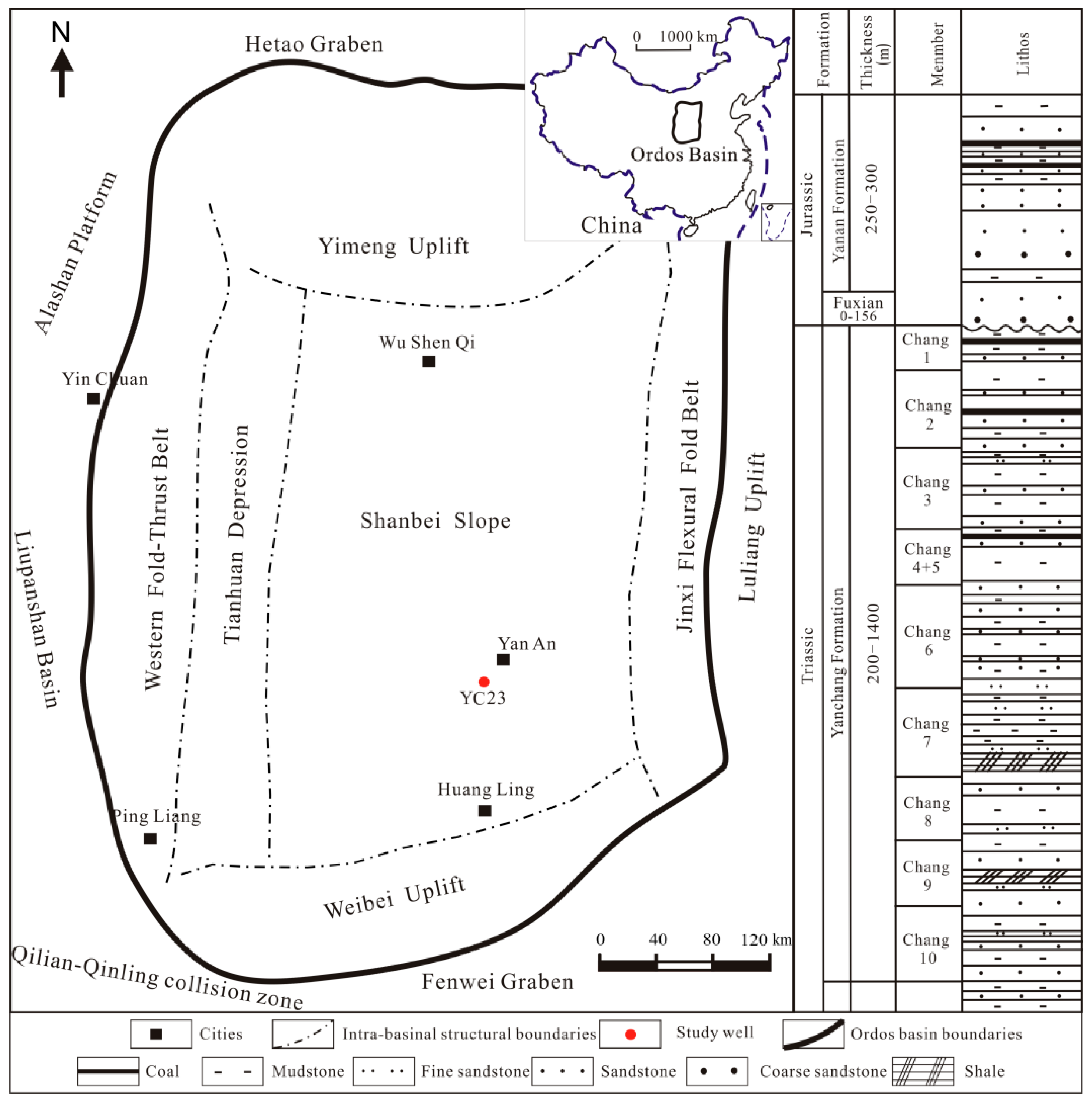

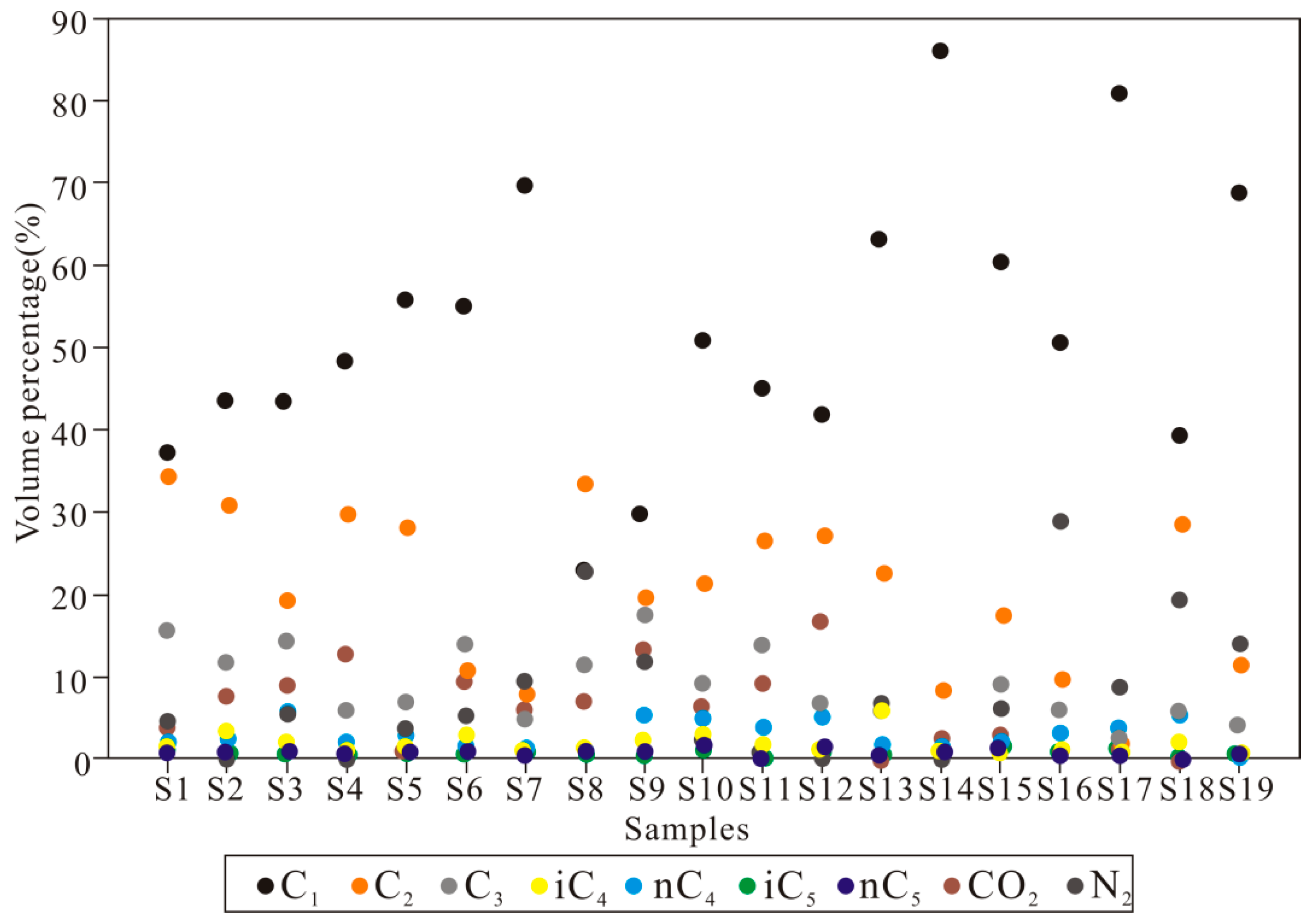
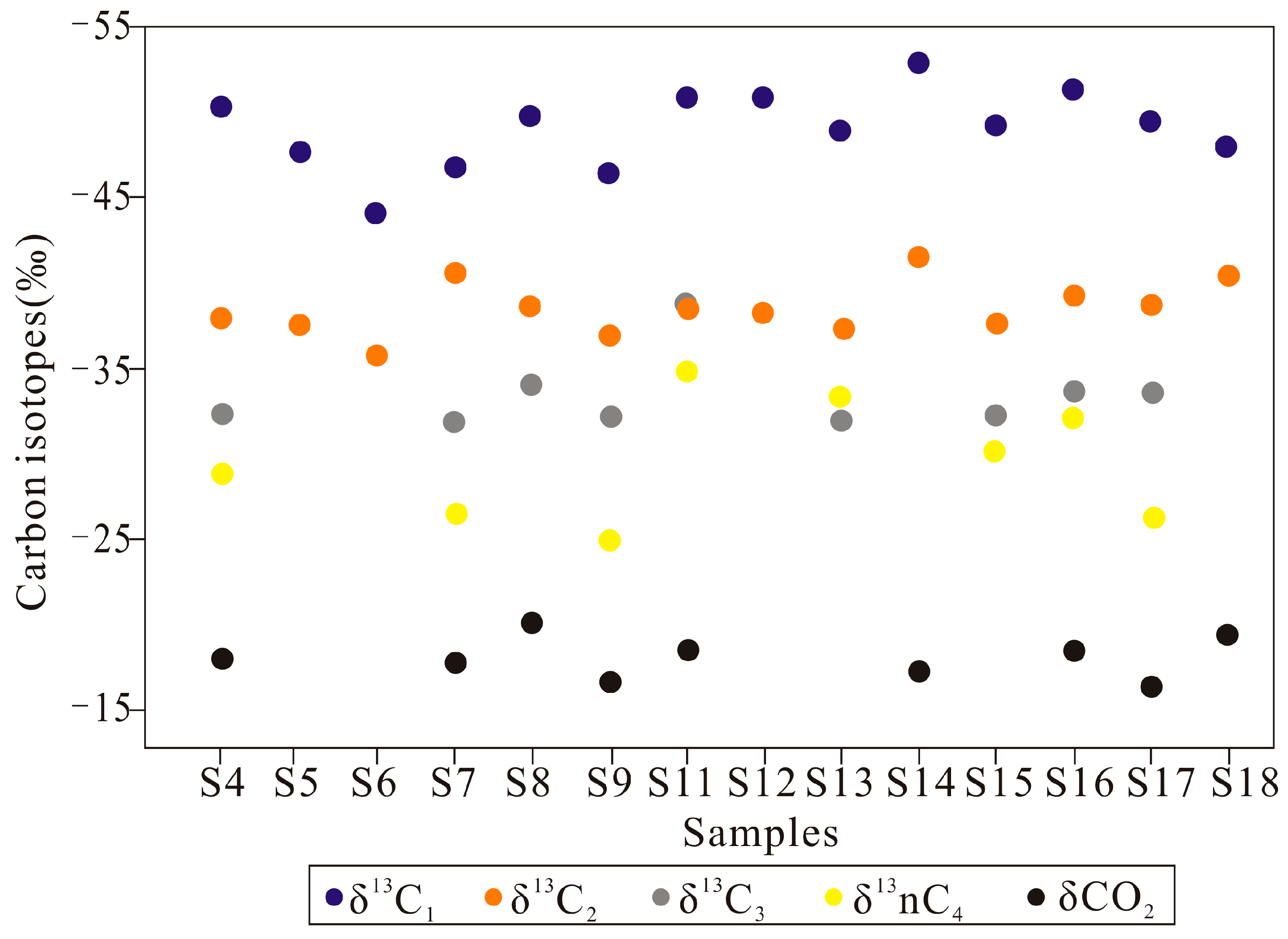
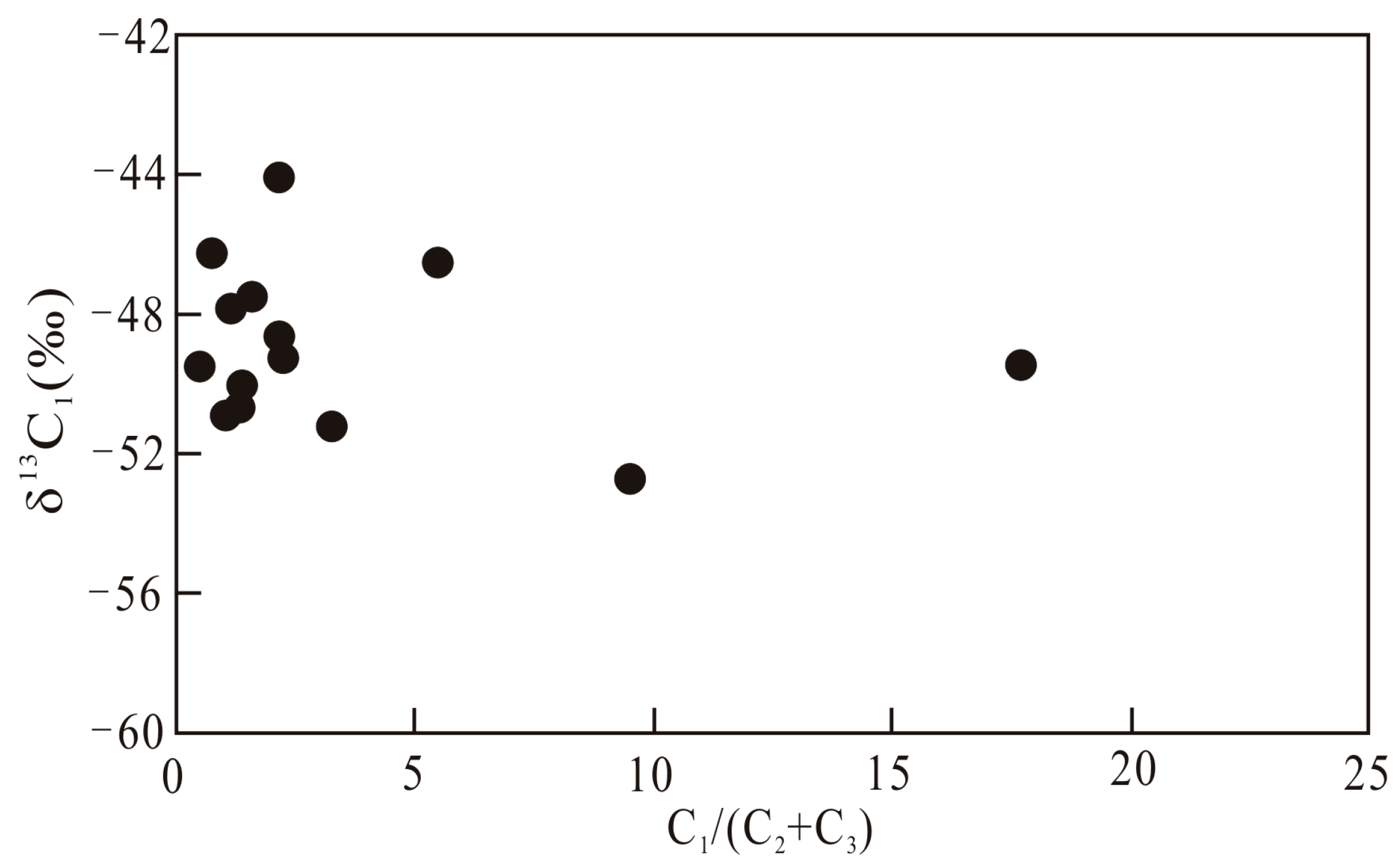

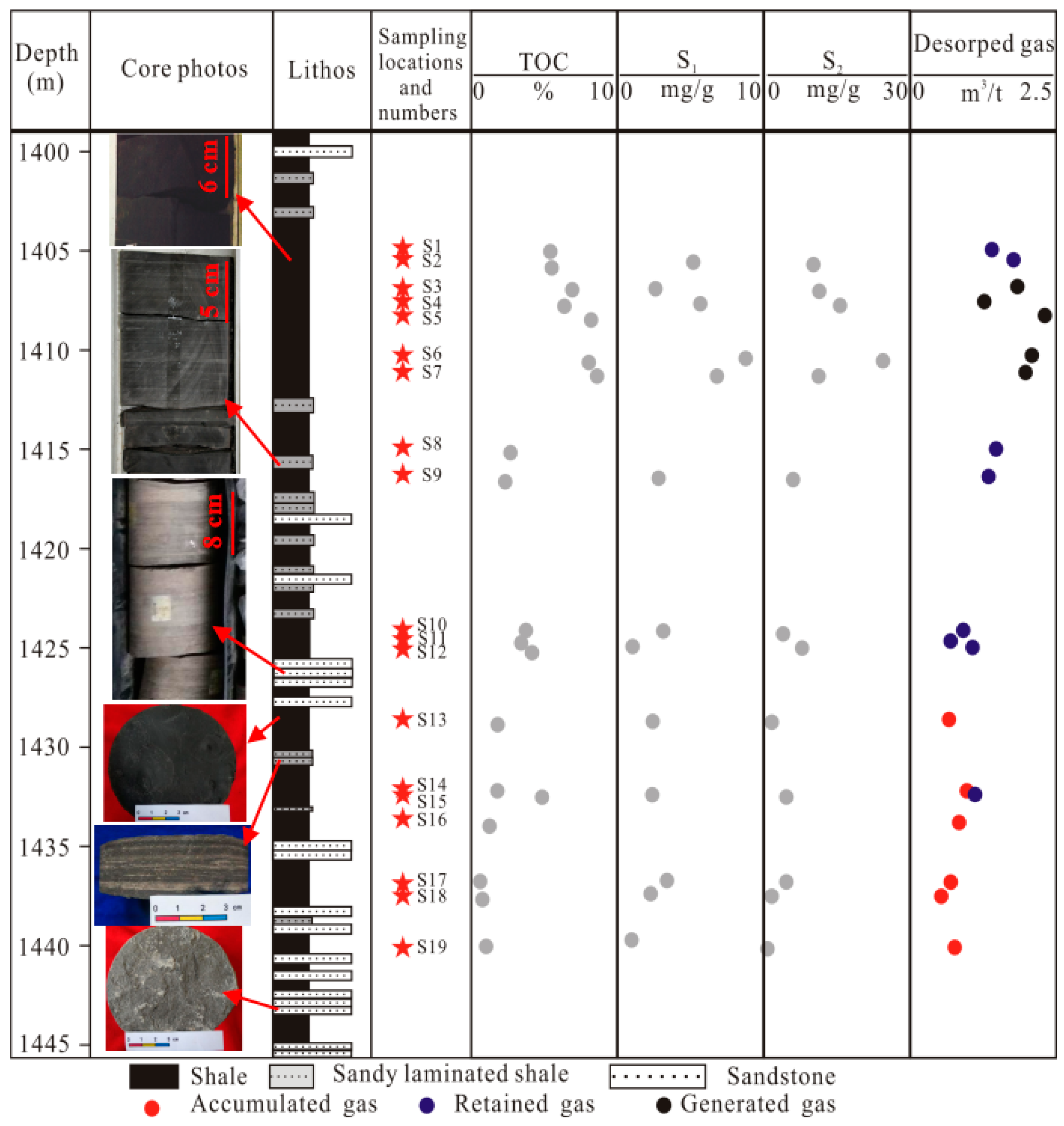
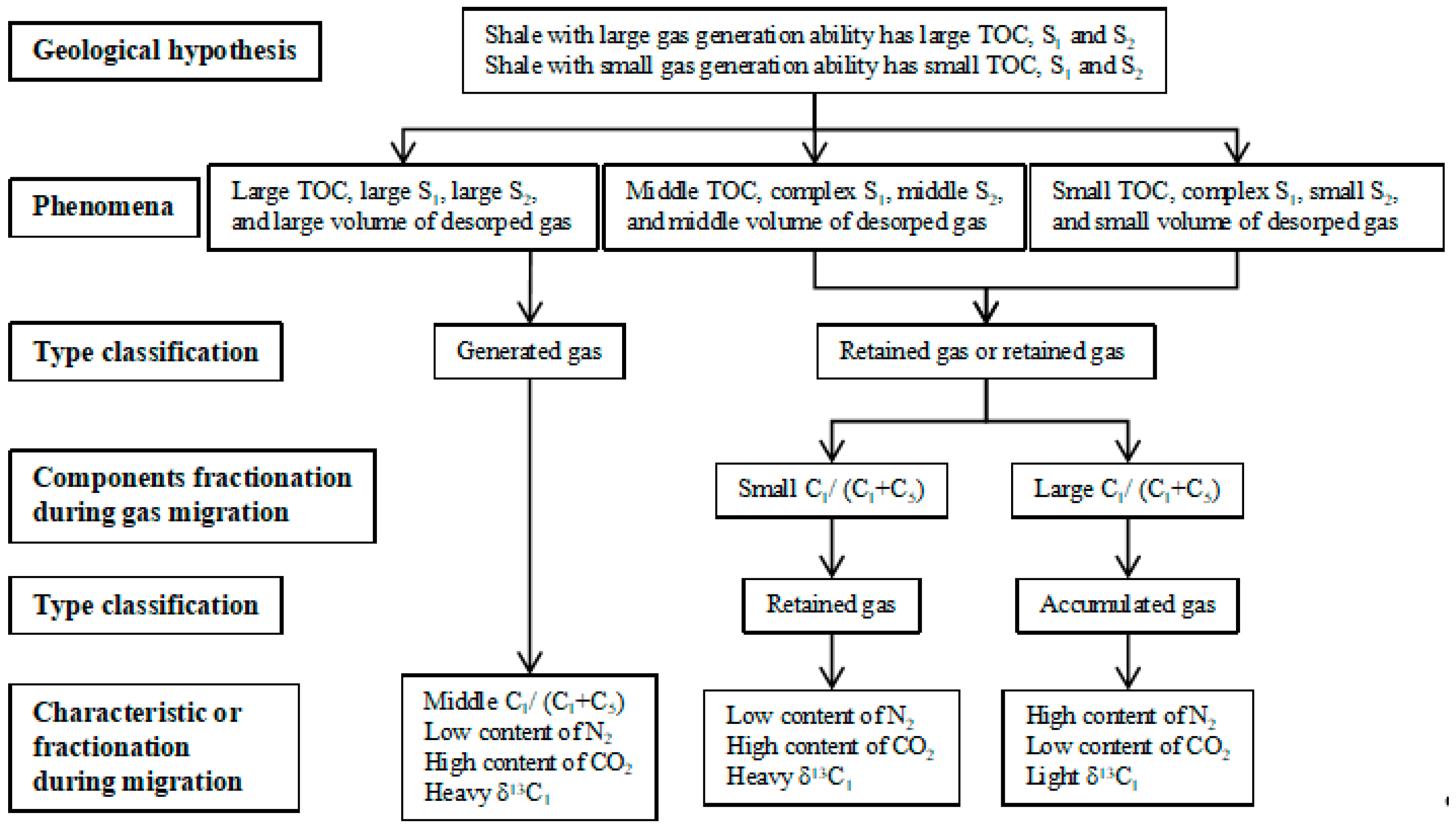
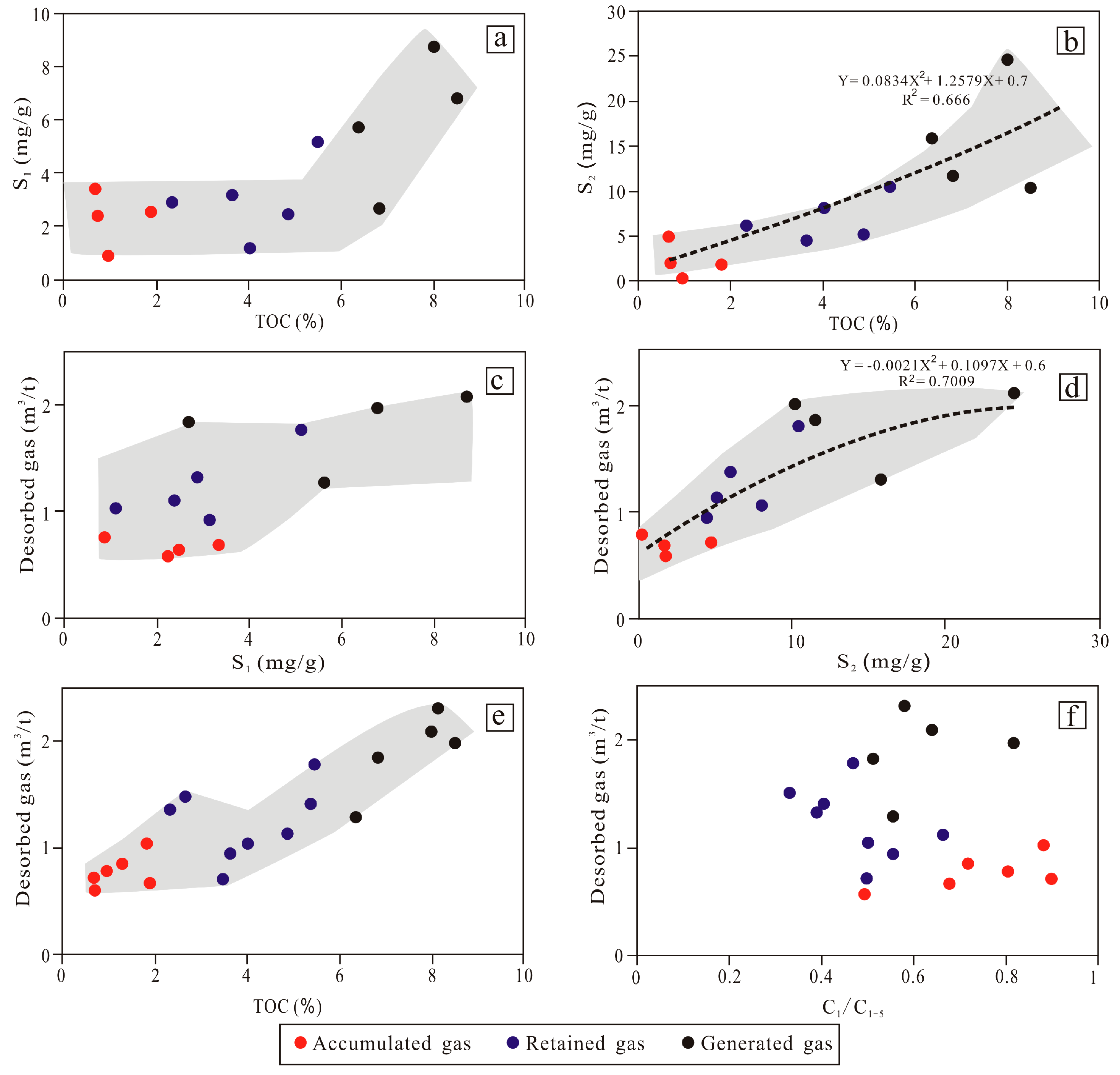
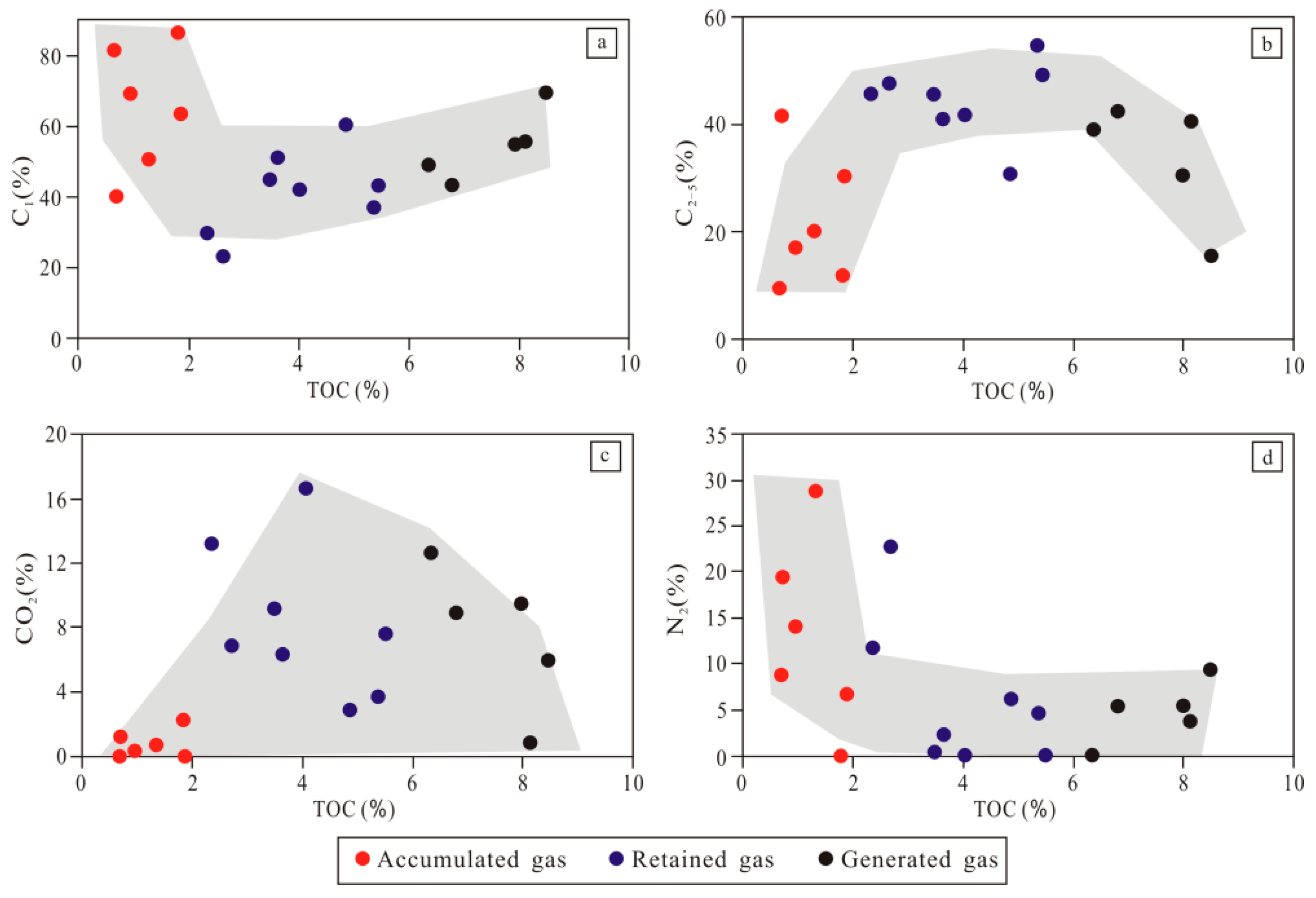

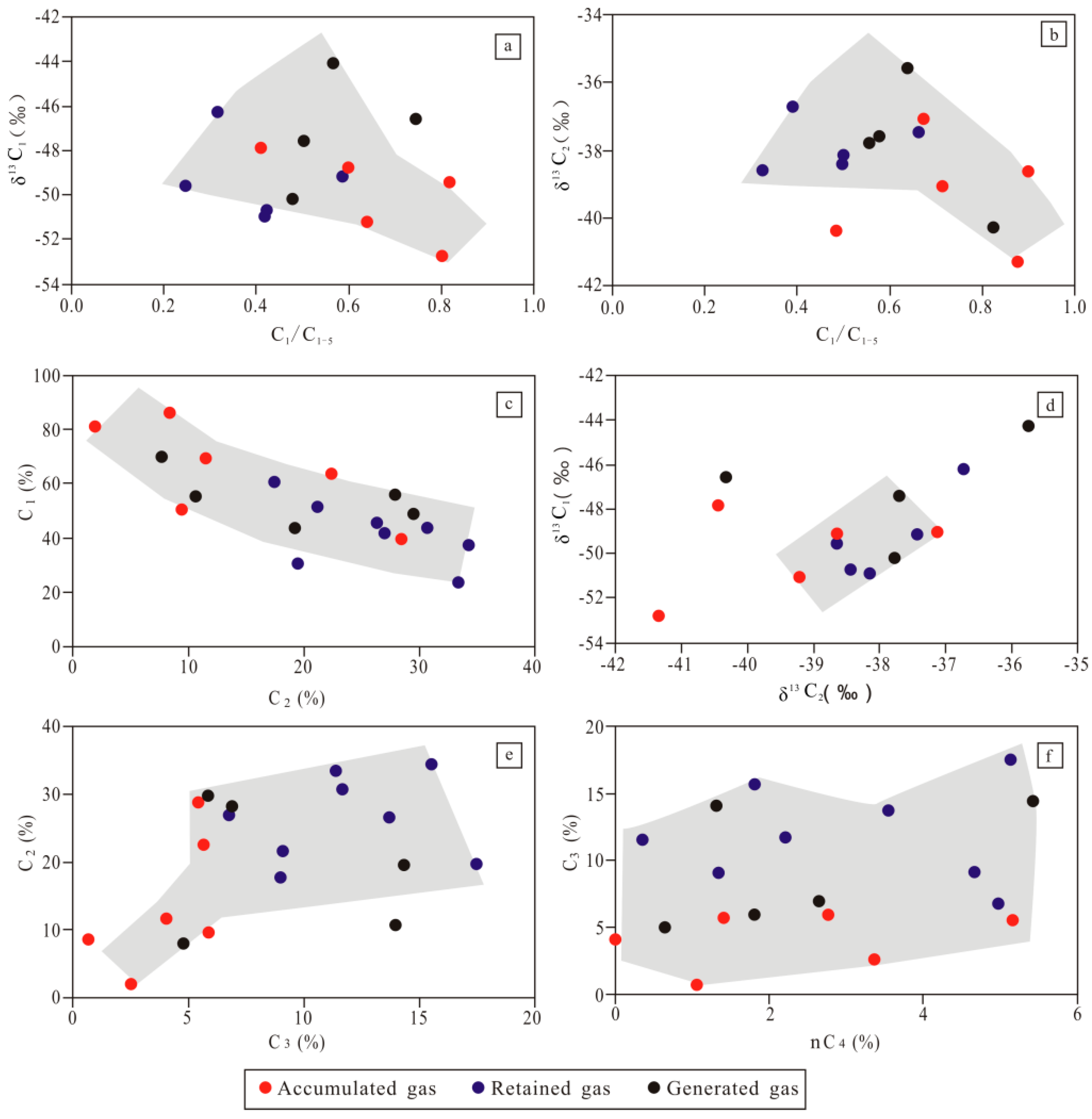
| Samples | Burial Depth (m) | S1 | S2 | TOC (%) | Tmax (°C) | HI | Desorbed Gas m3/t |
|---|---|---|---|---|---|---|---|
| S1 | 1405.13 | - | - | 5.37 | - | 198.51 | 1.41 |
| S2 | 1405.64 | 5.14 | 10.3 | 5.48 | 446 | 187.96 | 1.78 |
| S3 | 1406.97 | 2.64 | 11.56 | 6.83 | 455 | 169.25 | 1.84 |
| S4 | 1407.75 | 5.67 | 15.83 | 6.37 | 448 | 248.51 | 1.29 |
| S5 | 1408.44 | - | - | 8.15 | - | 219.02 | 2.32 |
| S6 | 1410.56 | 8.72 | 24.48 | 8.01 | 454 | 305.62 | 2.09 |
| S7 | 1411.27 | 6.78 | 10.23 | 8.52 | 455 | 202.23 | 1.98 |
| S8 | 1415.22 | - | - | 2.69 | - | 105.95 | 1.48 |
| S9 | 1417.16 | 2.85 | 6.04 | 2.35 | 452 | 257.02 | 1.36 |
| S10 | 1424.27 | 3.14 | 4.49 | 3.66 | 456 | 122.68 | 0.94 |
| S11 | 1424.78 | - | - | 3.48 | - | 180.17 | 0.71 |
| S12 | 1425.13 | 1.13 | 8.06 | 4.03 | 458 | 200.00 | 1.05 |
| S13 | 1429.46 | 2.48 | 1.8 | 1.89 | 447 | 95.24 | 0.66 |
| S14 | 1432.34 | - | - | 1.84 | - | 96.20 | 1.04 |
| S15 | 1432.54 | 2.4 | 5.17 | 4.88 | 455 | 105.94 | 1.12 |
| S16 | 1434.73 | - | - | 1.32 | - | 13.64 | 0.85 |
| S17 | 1436.85 | 3.36 | 4.79 | 0.68 | 459 | 704.41 | 0.71 |
| S18 | 1437.56 | 2.33 | 1.84 | 0.72 | 457 | 255.56 | 0.60 |
| S19 | 1440.23 | 0.88 | 0.06 | 0.96 | 455 | 6.25 | 0.78 |
| Types | Shale and Shale Gas Characteristics | ||||||
|---|---|---|---|---|---|---|---|
| Shale Thickness | Locations | TOC | Desorbed Gas (Average Value) | Volume of Generated Gas | Volume of Migrated Gas | Generated Gas or Migrated Gas | |
| Generated gas | 18 m | Middle part of thick shale | >6% | Large (3.80 m3/t) | Large | No or small | In situ-generated gas |
| Retained gas | - | Margin parts of thick shale or thin shale | 2%~6% | Middle (2.45 m3/t) | Large | Large | Part of in situ generated gas |
| Accumulated gas | <5 m | Thin shale | <2% | Small (1.54 m3/t) | Small | No or small | In situ-generated gas and migrated gas |
Publisher’s Note: MDPI stays neutral with regard to jurisdictional claims in published maps and institutional affiliations. |
© 2022 by the authors. Licensee MDPI, Basel, Switzerland. This article is an open access article distributed under the terms and conditions of the Creative Commons Attribution (CC BY) license (https://creativecommons.org/licenses/by/4.0/).
Share and Cite
Fan, B.; Shi, L.; Wang, X.; Wang, C.; Li, Y.; Huang, F. The Distribution of Gas Components within a Shale System and Its Implication for Migration. Minerals 2022, 12, 397. https://doi.org/10.3390/min12040397
Fan B, Shi L, Wang X, Wang C, Li Y, Huang F. The Distribution of Gas Components within a Shale System and Its Implication for Migration. Minerals. 2022; 12(4):397. https://doi.org/10.3390/min12040397
Chicago/Turabian StyleFan, Bojiang, Liang Shi, Xia Wang, Chi Wang, Yating Li, and Feifei Huang. 2022. "The Distribution of Gas Components within a Shale System and Its Implication for Migration" Minerals 12, no. 4: 397. https://doi.org/10.3390/min12040397
APA StyleFan, B., Shi, L., Wang, X., Wang, C., Li, Y., & Huang, F. (2022). The Distribution of Gas Components within a Shale System and Its Implication for Migration. Minerals, 12(4), 397. https://doi.org/10.3390/min12040397





